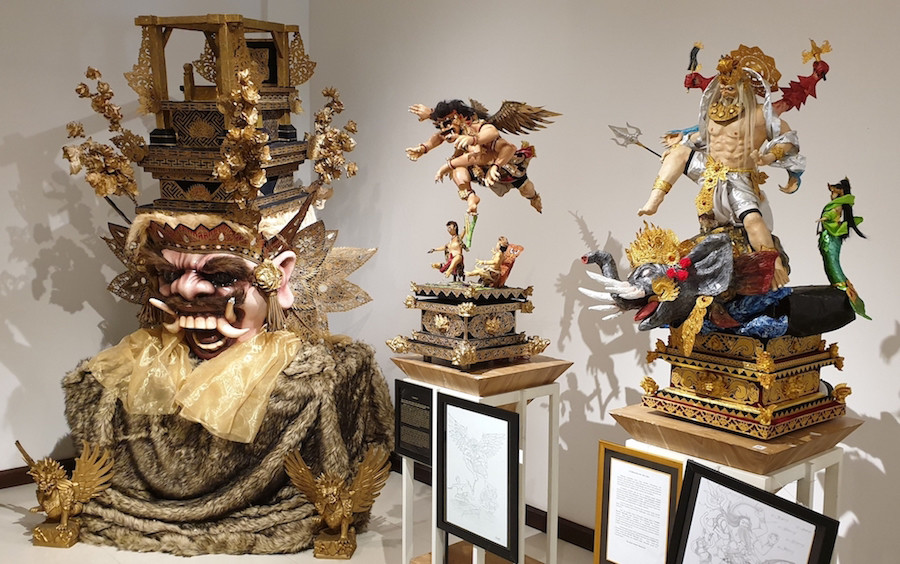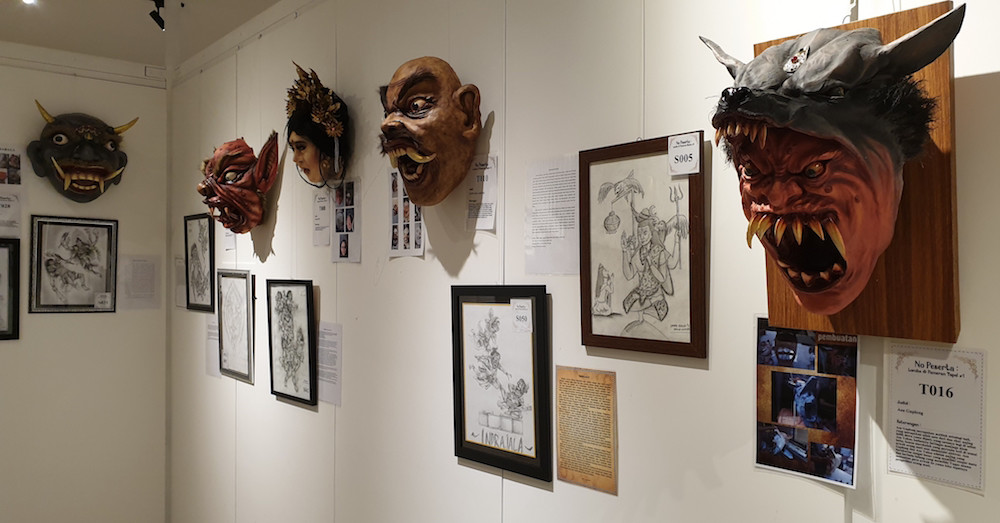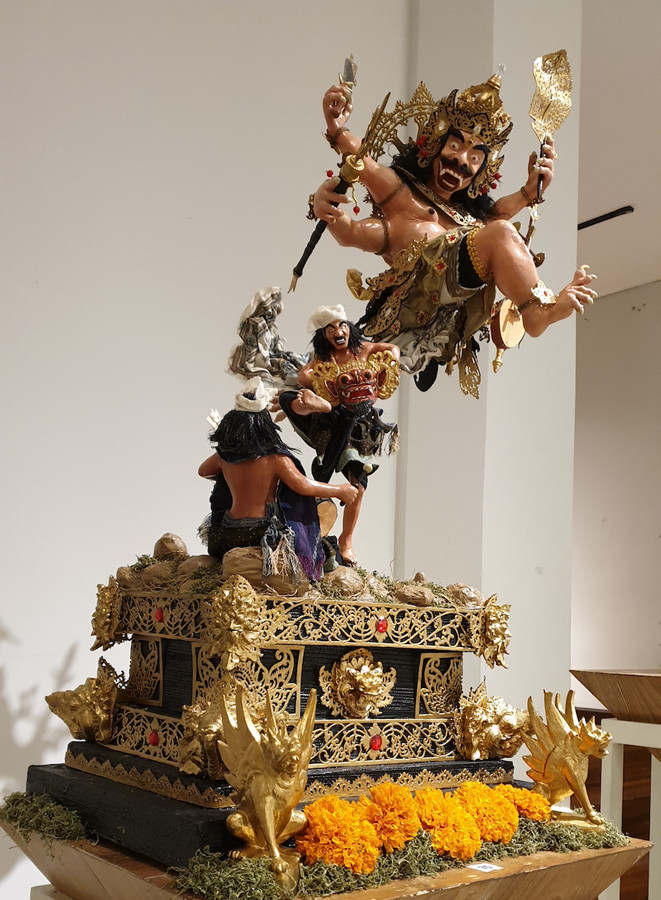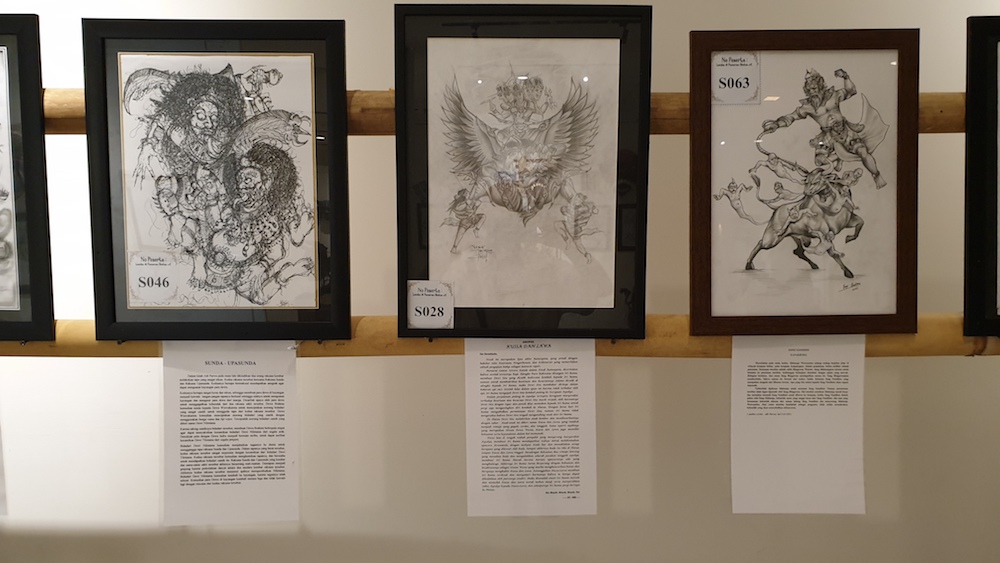One of the most fantastic artistic attributes of the Balinese culture is the Ogoh-ogoh. Extraordinary papier-mâché and bamboo representations of external and inner demons manifest as frightening giant sculptures. Ogoh-ogoh are paraded through village crossroads across Bali during the Ngrupuk parade on the eve of Nyepi. A cleansing ceremony that ushers in the first day of the Balinese new year according to the Saka calendar, the visual spectacle is an emotional rollercoaster – an annual highlight not to be missed for locals and visitors alike.
For the second consecutive year, the Bali provincial government Covid protocols enforced the banning of the Ngrupuk parade scheduled for the evening of the 11 March 2021. However, a revolutionary, spontaneous collective response led to a unique, first of its kind event. Stt Gemeh Indah, a youth group from Sekeha Teruna Teruni Banjar Gemeh, Denpasar and renowned art activist Marmar Herayukti, birthed the idea of a special event. An exhibition of Ogoh-ogoh artworks and competition at Dharmanegara Alaya Art & Creative Hub in Denpasar.

“The practice of creating Ogoh-ogoh is an exciting Balinese contemporary youth cultural phenomenon. It draws together community groups; children make works, young women participate in accompanying performances and even build their collective works. The Ngrupuk parade is a highlight of the youth social calendar,” said Wayan Hendaryana, Head of Tourism Resources and Creative Economy Division of the Denpasar City Tourism Office, operation managers of Dharmanegara Alaya (DNA).
“During months of collaborations, the youths discuss their experiences, share ideas and reflect upon the past year while preparing to ‘usher away’ and cleanse themselves and the community for the year ahead. Important social interaction occurs. The cooperation, creativity and late nights help develop unique bonds and relationships. When the event was cancelled again this year, the Balinese were very saddened.”

Sixty new works were on display in ‘Pameran Caka 1943’ at DNA, 7 – 30 March. The exhibition featured twenty Ogoh-ogoh sketches, twenty heads, masks and faces, twenty Ogoh-ogoh miniatures and photographs in Denpasar’s landmark new creative centre. Organized by Stt Gemeh Indah, well-known for the highly creative Ogoh-ogoh, the event was open to youth throughout Bali. Pencil sketches, along with descriptive texts, depicted spectacular and imaginative demonic creatures, the initial blueprints for the more significant 3-dimensional works.
The miniature Ogoh-ogoh Buta kala themed works inspired awe. The technical skills were superb, with extraordinary attention to detail. Some pieces featured tiny robotics enabling parts of the creatures to move and spin. The masks and headpieces, equally as aesthetically superb, brought chills to the spine. Larges pieces up to a 120 cm in height were not for the faint-hearted. “Over one-hundred and seventy entries were received, while the selection criteria included the value of the creative ideas, expression, ornamentation and philosophical references,” Marmar Herayukti told me. The first of a kind group exhibition attracted hundreds of daily visitors to DNA.
Dharmanegara Alaya (DNA) : A Centre for Balinese Creativity
“The Denpasar government believes that the city’s cultural identity will become stronger with the support of a modern economy. DNA will become a centre for the study and development of the creative economy for future generations,” Hendaryana told me. Inaugurated in late December 2019, the DNA building is a spacious modern facility combining traditional and contemporary architecture located on Jalan Gatot Subroto, North Denpasar. It is equipped with technology and spaces for exhibition, audiovisuals, reading, discussions, colour grading, maker spaces, classrooms, co-working spaces, an amphitheatre, and larger Taksu Theater, indoor and outdoor café along with the Denpasar City Radio. DNA supports a variety of creative community activities, such as performances, exhibitions, training and discussions.

“DNA’s vision and mission are in line with the Denpasar City Government mission of ‘Culture-Based Creative City Towards Advanced Denpasar’. This is an embodiment and synergy with the Bali provincial government and their ‘Nangun Sat Kerthi Loka Bali’ program,” said Putu Ayu Sada Devi Pradnyadari, a member of the DNA Creative Team. “The creative city concept focuses upon Denpasar as a Living City. It aims to provide dynamic awareness of natural resources to inspire innovation, human resources to inspire cultural dynamics, and spiritual resources to inspire creative projects. The culture is based upon religion becomes the spirit of creativity, both in the creation, preservation and improvement of the value order to maintain social order and balance.”
Dharmanegara Alaya means house of creativity, functioning as a form of state obligation to its citizens while referring to the duty of the citizens to their country. Dharmanegara is from the mayor and deputy mayor’s name at that time, the former Mayor of Denpasar, I.B. Rai Dharmawijaya Mantra, and his deputy, I G.N. Jayanegara, the founders of DNA. Abbreviated as DNA, it expresses the belief that the Denpasar people and the Balinese are born with potent creative DNA.

“As a creative hub, DNA collaborates with many diverse communities, organisations, and the general public in various fields. While much of Bali’s branding focuses on traditions, DNA has succeeded in giving the city a more casual and contemporary impression,” Ayu told me.
With official endorsement from the Indonesian government Minister of Tourism and Creative Economy, Sandiaga Uno and the Minister for Cooperatives and Small and Medium Enterprises Teten Masduki, along with the Bali Governor Wayan Koster, DNA provides an excellent working model to inspire the Bali provincial administration.
DNA Art and Creative Hub
Jalan Mulawarman, Duah Puri Kaja, North Denpasar
Instagram: @dharmanegara_alaya
Written by Richard Horstman, Bali art expert, at lifeasartasia.art and on Instagram @lifeasartartasia.









